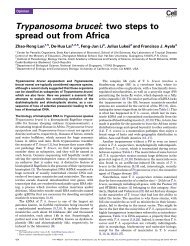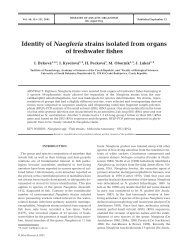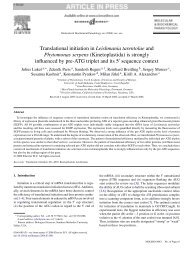Goussia Labbe´ , 1896 (Apicomplexa, Eimeriorina) - Institute of ...
Goussia Labbe´ , 1896 (Apicomplexa, Eimeriorina) - Institute of ...
Goussia Labbe´ , 1896 (Apicomplexa, Eimeriorina) - Institute of ...
Create successful ePaper yourself
Turn your PDF publications into a flip-book with our unique Google optimized e-Paper software.
128 M. Jirku˚ et al.<br />
(Figs 5, 12, 13). No morphological and morphometrical<br />
differences could be found between the four<br />
anuran isolates.<br />
In both squash and histological preparations,<br />
mature oocysts were frequently observed inside<br />
melanomacrophages in the lumina <strong>of</strong> liver sinusoids<br />
(Fig. 14) <strong>of</strong> all dissected tadpoles. The<br />
oocysts are transported to this extraintestinal<br />
location by the macrophages (Jirku˚ and Modry´<br />
2006). In addition, coprological, squash and<br />
histological examinations <strong>of</strong> gastrointestinal tracts<br />
<strong>of</strong> frogletts <strong>of</strong> R. dalmatina, previously experimentally<br />
infected as tadpoles were consistently negative<br />
up to 15 months post-metamorphosis. In<br />
contrast, presence <strong>of</strong> morphologically intact<br />
oocysts was observed in squash preparations <strong>of</strong><br />
liver <strong>of</strong> all these animals till the end <strong>of</strong> the<br />
experiment (15 months post-metamorphosis).<br />
Ultrastructure: Macrogamonts and sporogonic<br />
stages were observed in ultrathin sections<br />
<strong>of</strong> the intestines <strong>of</strong> R. dalmatina. The cytoplasm<br />
<strong>of</strong> macrogamonts (7.2—8.5 7.2—7.8 mm) contained<br />
numerous amylopectin granules and lipid<br />
inclusions (Fig. 15), and lacked wall-forming<br />
bodies. No parasitophorous vacuole enclosed<br />
the macrogamonts, the unit membrane <strong>of</strong> which<br />
seemed to communicate directly with the host cell<br />
cytoplasm. Pellicular projections into the host cell<br />
cytoplasm could be observed on the surface <strong>of</strong><br />
macrogamonts (Fig. 15). Zygotes or early oocysts<br />
(9.0—10.1 6.0—9.9 mm) (Fig. 16) differ from<br />
macrogamonts by the oocyst wall, which is in<br />
direct contact with host cell cytoplasm. No signs<br />
<strong>of</strong> an intervening membrane <strong>of</strong> the parasitophorous<br />
vacuole or an empty vacuolar space were<br />
observed. The oocyst wall is bilayered, composed<br />
<strong>of</strong> a thinner inner layer ( 7 nm) and a thicker outer<br />
layer ( 13 nm). In advanced oocysts, four sporoblasts<br />
bound by a unit membrane were formed,<br />
each enveloped by an additional loose membrane<br />
(Fig. 17). The space outside and inside this loose<br />
membrane(s) was filled with a sparse, foamy<br />
substance (Fig. 17). Next, advanced sporoblasts<br />
were covered by a bilayered membrane which<br />
eventually transformed into a thick sporocyst wall.<br />
The wall <strong>of</strong> fully developed sporocysts was<br />
apparently unilayered (28—30 nm thick) without<br />
any transverse striation (Fig. 19). The sporocyst<br />
wall widened up to 100 nm along the sutural line,<br />
which lacked any attached structures (Fig. 19).<br />
Sporocysts observed in SEM preparations had a<br />
smooth surface and a distinct curved longitudinal<br />
suture (Fig. 6). In mature oocysts, the space<br />
between sporocysts was filled with amorphous<br />
foamy material <strong>of</strong> variable density (Fig. 18). In all<br />
ARTICLE IN PRESS<br />
infections, aggregations <strong>of</strong> amylopectin granules<br />
representing deteriorated zygotes were observed<br />
together with mature oocysts within infected<br />
epithelial cells and yellow bodies (Fig. 22).<br />
The only discernible structures in the poorly preserved<br />
sporozoites were micronemes, a bilayered<br />
pellicle and two refractile bodies. The refractile<br />
bodies were <strong>of</strong> homogenous consistence, each<br />
surrounded by a distinct layer <strong>of</strong> fine amylopectin<br />
granules (Figs 20, 21). Sporozoites partly encircled<br />
the sporocyst residuum composed <strong>of</strong> amylopectin<br />
granules and lipid inclusions with an intervening<br />
cement (Fig. 20).<br />
Pathology: On the ultrastructural level, host<br />
cells <strong>of</strong> R. dalmatina containing the sporogonic<br />
stages demonstrated progressive cytoplasmic<br />
degradation characterized by cytoplasm homogenisation,<br />
degeneration <strong>of</strong> organelles and<br />
appearance <strong>of</strong> a multilaminated matrix. Such<br />
deteriorated host cells gradually lost integrity,<br />
<strong>of</strong>ten fused together and became the yellow<br />
bodies usually containing several oocysts or<br />
zygotes (Fig. 22). The yellow bodies were subsequently<br />
released from the epithelial layer into the<br />
intestinal lumen (Fig. 23).<br />
Despite heavy infections, no inflammatory<br />
response was observed in histological sections<br />
<strong>of</strong> infected tissues, but significant histopathological<br />
changes were present during culmination <strong>of</strong><br />
the infection, indicated by a presence <strong>of</strong> sporogonic<br />
stages. In such cases, the intestinal<br />
epithelium appeared to be disintegrated, with<br />
intervening foci <strong>of</strong> sporogonic stages associated<br />
with the yellow bodies (Figs 12, 13) or empty<br />
spaces left after their release. Most <strong>of</strong> the volume<br />
<strong>of</strong> affected enterocytes was thus occupied by<br />
sporogonic stages and the yellow bodies (Fig. 13).<br />
Despite such obvious pathology, animals which<br />
were not dissected and shed comparable quantities<br />
<strong>of</strong> oocysts as the histologically examined<br />
ones, showed no mortality and successfully<br />
completed the metamorphosis. At the level <strong>of</strong><br />
histopathology, no differences were observed<br />
between the four isolates.<br />
Transmission experiments: Most experimental<br />
trials (Table 2) suffered from the failure <strong>of</strong> negative<br />
controls, probably as a result <strong>of</strong> contamination,<br />
and cannot be classified as reliable (indicated by<br />
stars in Table 2). Of 25 trials involving European<br />
anurans, 16 resulted in infections, and only the<br />
infections <strong>of</strong> R. dalmatina tadpoles with isolates<br />
<strong>of</strong> G. noelleri originating from R. dalmatina and<br />
R. temporaria had proper negative controls and<br />
can be regarded as reliable. Tadpoles or adults<br />
<strong>of</strong> Xenopus laevis and Pleurodeles waltl never








